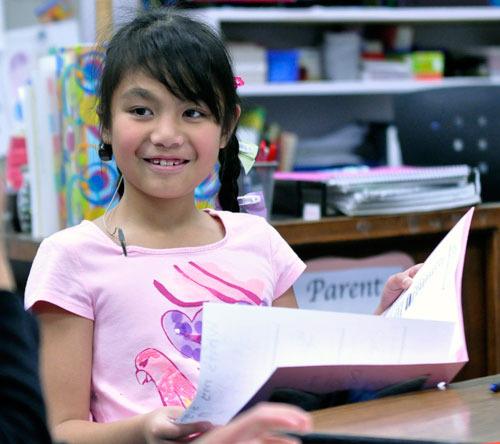SHORELINE — Marysville’s Matthea Balcago is considered profoundly deaf. She cannot hear at all. As an elementary student in the Ferndale School District, Balcago was struggling to learn — not because she wasn’t capable, but because there weren’t enough resources in the school to adequately educate a deaf child.
“The school wasn’t helping her,” said Matthea’s mother, Maita Gaines. “She was not getting all the resources she needed, like a one-on-one speech/deaf teacher. She didn’t have peers at school, since she was the only one who is deaf, so her socialization was really low. Her speech pathologist advised us to go visit Northwest School for Hearing-Impaired Children to see if that would be the best school for Matthea.”
The Northwest School for Hearing-Impaired Children is the only school of its kind in the country. There are currently 40 students enrolled from across the state.
“We contract with 22 school districts in Washington,” said Dr. Barb Luetke, Outreach and Literacy Coordinator for the school, a former professor who trained teachers of the deaf and has written several books on the subject. “The state is required to provide adequate education for every student, so since we contract with the schools, parents do not have to pay anything for tuition or transportation.”
The school was founded by two teachers of the deaf in 1982, Karen Appelman and Judy Callahan. For more than 30 years, the school has focused on teaching students in a way that will increase their success after they graduate from the program. The school’s students have a 100 percent high school graduation rate and 65 percent of students will graduate from college. Eighty-five percent of the school’s former students have jobs and are living on their own. Those statistics well exceed national averages — a 2001 study conducted by researchers in the field found only 30 percent of all young adults who were deaf or hard of hearing received college degrees, 63 percent were employed and 42 percent lived on their own.
Matthea’s family decided to move to Marysville to be closer to the school, so that she could take the bus to Shoreline everyday.
“It was a six-month process — visiting the school and working on her IEP. I had to fight for her in order for the Ferndale School District to cover the expenses that she needs, until the district decided to send her,” said Gaines. “And then the bus ride was three hours going to Shoreline and three hours going back home. We did that for a year, and I said to myself, ‘If I see a lot of progress in her, after a year we can move and let her stay in that school.’” After a year, the family moved to Marysville because the progress in her learning was so amazing.
“We saw far beyond what we expected for Matthea,” said Gaines. “Going to the school improved her socialization and self esteem. She is talking, signing a lot and initiating conversations. She is more into her studies and is more disciplined. She can hear, because she has a cochlear implant on her right ear and they are doing Signing Exact English, where they have to sign every word in the sentence. In ASL, you just have to sign the major word. Using SEE has really helped too because she can read now. She is at her grade level in reading, which is really unexpected because she is deaf and so her reading should be delayed, but I think she is catching up.”
At NWSFHIC, the emphasis is on proper communication, both spoken and signed.
“Here we focus on speech, listening, English grammar and a regular academic curriculum,” said Luetke. “The book that Matthea is reading right now is a book approved for teaching in a hearing classroom.”
The school uses a language called Signing Exact English, rather than American Sign Language. The difference between the two is that with ASL, there is a sign for significant words in a sentence, while with SEE, the signs translate exactly as they would in the English language.
“ASL does not have a written translation,” said Luetke. “We use English, we read English and we sign English grammatically correctly and we make sure that the grammar is the same as in a hearing classroom. SEE helps children make sense of the auditory input provided by their cochlear implants or hearing aids. If they can’t hear certain words or parts of words, we supply them with SEE signs so that grammatically correct English is developed for academics and social communication.”
Using SEE is part of what helps each student learn and improve their skills in communication and reading, as well as socialization with non-deaf children. Teachers wear a microphone on their shirts and each child’s equipment is tuned to their teacher’s voice, which helps them hear as much of the spoken word as possible. Each student at the NWSFHIC receives 15 minutes of one-on-one tutoring per day. The teacher to student ratio is roughly one teacher for every three students, and the teachers are certified teachers of the deaf. The school begins teaching students as young as 3 years old and runs through eighth grade.
For Matthea, the difference in her experience at school is life-changing.
“She is more easy-going right now,” said Gaines. “Before she didn’t have friends, even deaf or hard of hearing kids. She had a hard time socializing with others, but now it’s easy for her to be with friends. She is more happy being with the hearing kids too, because it’s how she learns. She is so involved in sports now, too. Having hearing kids and deaf kids together helps her in understanding more about sports. She is in swimming, volleyball, bowling and that’s really cool also. It really helps her to be in that school.”
For more information on NWSFHIC, visit www.northwestschool.com.


